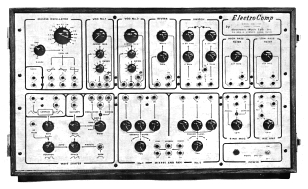ElectroComp EML-200
EML was a Connecticut company whose original purpose was to create affordable synthesizers for educational purposes. Word of their
products got out and they soon became popular among many musicians as well. One of their earlier releases was the ElectroComp model
EML-200. Available in silver or blue, this keyboardless synthesizer was housed in a beautiful wooden cabinet. Sounds had to be patched
with cables as there were no hardwired connections. The EML-101 was a keyboard synthesizer built into a suitcase. The keyboard filled
one half while the synthesizer module filled the other. Perhaps the most unusual of the ElectroComps was the ElectroComp Sequencer EML
400 (also known as the EML-401 and EML-416) was half analog sequencer, half synthesizer. Like the EML-200, it too was built into a wooden
case. The lid of the case housed the sequencer controls—96 faders and assorted switches. The EML-500 was similar to but more complete
than the synthesizer section of the 400. The gorgeous orange EML Poly-Box was a 1-octave keyboard allowing polyphonic performance on
monophonic instruments. Other EML products included the SynKey as well as the EML modular, which was available in only partially assembled form.
ElectroComp EML-200 — a panel description
- NOISE GENERATOR. The Noise Generator is a sound source for producing wind, thunder, and percussive effects. It produces white noise
which contains all the audible frequencies. The Noise Generator can be used to produce random triggers and pitches when used in combination
with the other synthesizer functions.
- MASTER OSCILLATOR. The Master Oscillator is a wide range, manually tunable oscillator. It produces a pitch proportional to the setting
of its range switch and tuning control. Six overlapping ranges are provided covering both the audio and sub audio spectrums—.01 to 18,000
cycles per second. Three waveforms are simultaneously available—sine, triangle and square.
- VOLTAGE CONTROLLED OSCILLATORS. The two Voltage Controlled Oscillators cover the audio range and produce sawtooth waveforms. Each
oscillator has two control inputs with attenuators. The Master Oscillator, Sampler, Envelope Generator and any of the optional keyboards
may be used at these inputs to produce variations in pitch. The Master Oscillator could be used to produce various types of vibratos of
different speeds. The Sampler to generate a series of ordered or random pitches. The Envelope Generator to produce sweeping pitches. The
Keyboards to produce discrete pitches of fixed interval. The pitch of the VCO's can also be adjusted manually.
- REVERB. The Reverb is used to delay any audio signal connected to its input. In the process it adds body and depth to the original signal.
The Reverb contains a depth control for proportioning the amount of reverberated and unreverberated signal and an output attenuator for
adjusting the volume. The Reverb may also be used as a waveform inverter.
- ELECTRONIC SWITCH. The Electronic Switch alternates two audio sound sources to a single output. The duration of each source at the
output is independently adjustable and is determined by an internal variable ratio oscillator. This ratio may be varied over a 300 to 1
range. External triggers may be used in place of the internal oscillator.
- HIGH PASS FlLTER. The High Pass Filter passes the highs and weakens the lows present in any audio source connected to its input.
The cutoff frequency (where the lows start to be attenuated) is manually adjustable over a 30 to 1 range.
- LOW PASS FILTER. The Low Pass Filter passes the lows and weakens the highs present in any audio sound source connected to its input.
The cutoff frequency is adjustable over a 30 to 1 range. The High Pass and Low Pass filters may be combined to produce band pass or
band reject filters.
- MICROPHONE AMPLIFIER. The Microphone Amplifier permits the introduction of external sound sources through the use of microphones and
electric pickups.
- MODULATORS. There are two Modulators within the synthesizer. Each of them is capable of producing ring modulation. They both have a
D.C. coupled input and therefore can be used in combination with the Envelope Generators to produce amplitude modulation.
- STEREO MIXERS. The two Mixers each have 3 inputs with volume attenuators. Through use of the Pan controls, the two mixers may be
combined into a single mixer with six inputs.
- PAN CONTROLS. The Pan Controls permit any portion of the left mixer to be added to the right, or any portion of the right mixer to
be added to the left, and therefore can be used to produce crossing effects.
- ENVELOPE GENERATOR. The Envelope Generator produces a waveform for shaping pitch and loudness. It may be triggered by the Sampler's
internal oscillator, a manual trigger, keyboard or other oscillators.
- SAMPLER. The Sampler produces a waveform for generating random or ordered sequences of tones. A variable ratio oscillator is provided
in the sampler for determining the sampling speed and to trigger the Sampler's associated envelope generator.
- PATCH PANEL. The Patch Panel provides inputs and outputs for every function contained within the synthesizer. This is particularly
handy for the beginning electronic composer because it permits him to concentrate on one dimension a a time. Output impedances are
470 ohms and are well matched for all professional equipment. All outputs are short circuit proof. For your convenience and reliability,
standard size phone jacks and plugs are used throughout. The Patch Panel also permits you to inexpensively expand your studio by
adding keyboards and sequencers as your budget permits.
- CASE. The 200's case consists of a rugged, aluminum splined mahogany core, covered with wood-grained formica. It comes with a
cover and weighs 32 pounds.
